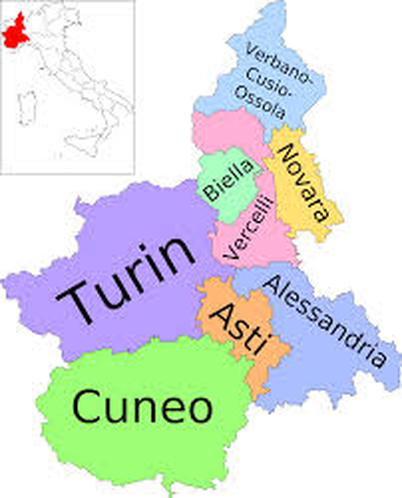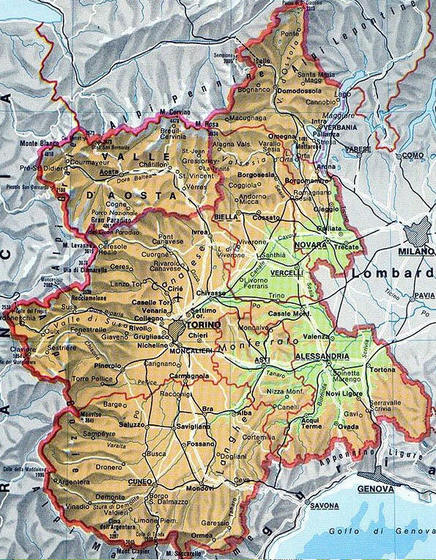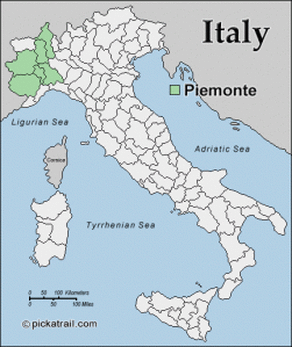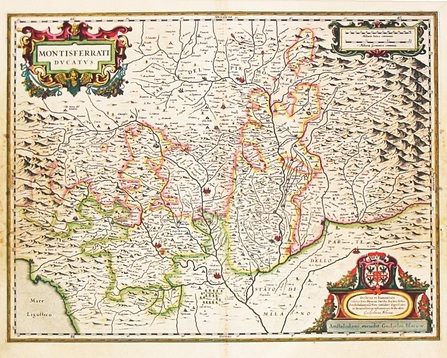GEOGRAPHY OF PIEMONTE
The region of Piemonte (Piedmont) is situated in the northwest corner of Italy, bordering on Switzerland to the north, the region of Valle d’Aosta to the northwest, France to the west, the region of Liguria to the South, and the region of Lombardia to the east. Piemonte extends for approximately 25,400 square kilometers. Its population is about 5 million people.
Piemonte has no access to the sea. Its territory is surrounded from south to west to north by a complete arc of the Alps mountain range; hence, the name of the region, which means “at the foot of the mountains.” The Piedmontese part of the Alpine range is divided into five sub-ranges called respectively the Maritime, Cozie, Graie, Pennine and Lepontine Alps. The highest mountain in Europe, Mt. Blanc (approx. 16,000 ft.), is between the Graie and Pennine Alps on the border between Valle d’Aosta and France. Other famous mountains are the Cervino (also known as the Matterhorn), 14,950 ft. high at the border between Valle d’Aosta and Switzerland, and MonViso (12,800 ft.), the highest peak entirely within Piemonte, which is where the longest river in Italy, the Po, has its source. The rest of Piemonte opens to the east onto the Pianura Padana (the Po valley plains), where the famous Arborio type of rice is cultivated (in the area around Novara and Vercelli), and to the southeast to the so-called Langhe area. This is Piemonte’s wine country, consisting of the hills roughly between Cuneo and Asti. In this area, some of the most famous red wines of Italy are produced, including Barolo (the “king of the wines and the wine of the Kings”), Barbaresco, Nebbiolo, Dolcetto and Barbera. Asti is also famous for its Spumante, a sweet sparkling wine.
The regional capital of Piemonte is the city of Torino (Turin), which is located approximately at the center of the region in the plains at the confluence of the three rivers Po, Dora Baltea and Dora Riparia and has a population of about 1 million. Torino is also a provincial seat (a province is an administrative entity similar to a US county). There are seven other provinces in Piemonte; proceeding counterclockwise from northeast, these are: Verbania, Novara, Biella, Cuneo, Alessandria, Asti, and Vercelli. The provinces of Verbania and Biella were added in the 1990s; until WWII, Piemonte also included the province of Aosta, which then became an autonomous region, called Valle d’Aosta (much as the City and County of San Francisco). Valle d’Aosta is the smallest Italian region; it is officially bilingual (Italian and French).
The prevalent religion in Piemonte is Roman Catholicism; however, there are substantial Protestant communities, including one of the oldest Protestant community in Europe, the Waldensians, which predate the Lutheran schism. This group is mostly located in the Val Pellice to the west of Torino towards the French border. There are also many ancient Jewish communities scattered in Piemonte; however, the local Jewish congregations have dramatically dwindled in the recent decades. The recent wave of immigrants from the Middle East and North Africa has also brought a sizable number of Muslims into Piemonte. As a territory of the Roman Catholic church, Piemonte is divided into sixteen dioceses (Torino, Acqui, Alba, Alessandria, Asti, Biella, Casale, Cuneo, Fossano, Ivrea, Mondovi’, Novara, Pinerolo, Saluzzo, Susa, Vercelli). Of these dioceses, two (Torino and Vercelli) are metropolitan sees, and only one (Torino) is an archdiocese. Since the nineteenth century, the archbishop of Torino is traditionally a Cardinal.
Source: Enciclopedia Italiana (Treccani)
Compiled and Edited by Professor Albert Milani and Claudia Biorcio-Milani
The region of Piemonte (Piedmont) is situated in the northwest corner of Italy, bordering on Switzerland to the north, the region of Valle d’Aosta to the northwest, France to the west, the region of Liguria to the South, and the region of Lombardia to the east. Piemonte extends for approximately 25,400 square kilometers. Its population is about 5 million people.
Piemonte has no access to the sea. Its territory is surrounded from south to west to north by a complete arc of the Alps mountain range; hence, the name of the region, which means “at the foot of the mountains.” The Piedmontese part of the Alpine range is divided into five sub-ranges called respectively the Maritime, Cozie, Graie, Pennine and Lepontine Alps. The highest mountain in Europe, Mt. Blanc (approx. 16,000 ft.), is between the Graie and Pennine Alps on the border between Valle d’Aosta and France. Other famous mountains are the Cervino (also known as the Matterhorn), 14,950 ft. high at the border between Valle d’Aosta and Switzerland, and MonViso (12,800 ft.), the highest peak entirely within Piemonte, which is where the longest river in Italy, the Po, has its source. The rest of Piemonte opens to the east onto the Pianura Padana (the Po valley plains), where the famous Arborio type of rice is cultivated (in the area around Novara and Vercelli), and to the southeast to the so-called Langhe area. This is Piemonte’s wine country, consisting of the hills roughly between Cuneo and Asti. In this area, some of the most famous red wines of Italy are produced, including Barolo (the “king of the wines and the wine of the Kings”), Barbaresco, Nebbiolo, Dolcetto and Barbera. Asti is also famous for its Spumante, a sweet sparkling wine.
The regional capital of Piemonte is the city of Torino (Turin), which is located approximately at the center of the region in the plains at the confluence of the three rivers Po, Dora Baltea and Dora Riparia and has a population of about 1 million. Torino is also a provincial seat (a province is an administrative entity similar to a US county). There are seven other provinces in Piemonte; proceeding counterclockwise from northeast, these are: Verbania, Novara, Biella, Cuneo, Alessandria, Asti, and Vercelli. The provinces of Verbania and Biella were added in the 1990s; until WWII, Piemonte also included the province of Aosta, which then became an autonomous region, called Valle d’Aosta (much as the City and County of San Francisco). Valle d’Aosta is the smallest Italian region; it is officially bilingual (Italian and French).
The prevalent religion in Piemonte is Roman Catholicism; however, there are substantial Protestant communities, including one of the oldest Protestant community in Europe, the Waldensians, which predate the Lutheran schism. This group is mostly located in the Val Pellice to the west of Torino towards the French border. There are also many ancient Jewish communities scattered in Piemonte; however, the local Jewish congregations have dramatically dwindled in the recent decades. The recent wave of immigrants from the Middle East and North Africa has also brought a sizable number of Muslims into Piemonte. As a territory of the Roman Catholic church, Piemonte is divided into sixteen dioceses (Torino, Acqui, Alba, Alessandria, Asti, Biella, Casale, Cuneo, Fossano, Ivrea, Mondovi’, Novara, Pinerolo, Saluzzo, Susa, Vercelli). Of these dioceses, two (Torino and Vercelli) are metropolitan sees, and only one (Torino) is an archdiocese. Since the nineteenth century, the archbishop of Torino is traditionally a Cardinal.
Source: Enciclopedia Italiana (Treccani)
Compiled and Edited by Professor Albert Milani and Claudia Biorcio-Milani




